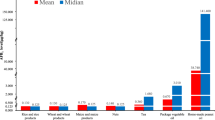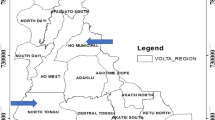Abstract
Aflatoxins (AFs) are frequent contaminants in crops worldwide and can cause adverse health effects in exposed humans. Since foods AFs (AFB1, AFB2, AFG1, AFG2) contamination in Sichuan Province are unexplored, we conducted a study to assess AFs exposure in the population. In total, 318 samples, including grains, red chilli, red chilli powder, and vegetable protein beverages, were collected from 13 cities of Sichuan Province, China, in 2022. AFs were detected in all types of foods except for wheat flour, the highest incidence was found in red chilli powder (75.0%). The concentrations of AFtot (the total aflatoxins) ranged between ND (not detected) and 54.20 μg kg−1. It was observed that the AFs profile was dominated by AFB1. The AFB1 content ranged from ND to 52.60 μg kg−1 across food types. According to EU maximum limits (ML) of AFs, 2.8% of samples exceeded the AFtot limits. For AFB1, 0.4% and 4.3% of samples exceeded the China and EU limits, respectively. In this study, packaging types and sampling sites were selected as parameters influence food aflatoxin contamination. Nevertheless, there was no significant difference between different samples. According to exposure assessment and risk characterization, AFtot daily exposure was shown to be 0.263 and 283.936 ng kg−1 bw for the lower and upper exposure. The MOE value derived from consumption grains and red chilli pepper products were generally bellow 10 000, and liver cancer cases based on these two foods consumption could range from < 0.001 to 0.16 cases per year/10 000 persons.
Similar content being viewed by others
Data Availability
The data that support the findings of this study are available on request from the corresponding author. The data are not publicly available due to privacy or ethical restrictions.
References
Additives JFWE (1999) Evaluation of certain food additives and contaminants. Forty-ninth report of the Joint FAO/WHO Expert Committee on Food Additives. World Health Organ Tech Rep Ser 884:1–96
Agriopoulou S, Stamatelopoulou E et al (2020) Advances in occurrence, importance, and mycotoxin control strategies: prevention and detoxification in foods. Foods 9(2):137
Akhund S, Akram A et al (2017) Pre-harvest aflatoxins and Aspergillus flavus contamination in variable germplasms of red chillies from Kunri, Pakistan. Mycotoxin Res 33(2):147–155
Benkerroum N (2020) Aflatoxins: producing-molds, structure, health issues and incidence in Southeast Asian and Sub-Saharan African countries. Int J Environ Res Public Health 17(4):1215
Berthiller F (2010) Climate change impacts on natural toxins in food production systems, exemplified by deoxynivalenol in wheat and diarrhetic shellfish toxins. Food Addit Contam Part A 27(5):575–575
Chen T, Liu J et al (2022) Burden of disease associated with dietary exposure to aflatoxins in China in 2020. Nutrients 14(5):1027
Daou R, Joubrane K et al (2021) Aflatoxin B(1) and ochratoxin A in imported and Lebanese wheat and -products. Food Addit Contam Part B Surveill 14(3):227–235
Ding X, Wu L et al (2015) Risk assessment on dietary exposure to aflatoxin b1 in post-harvest peanuts in the Yangtze River ecological region. Toxins 7(10):4157–4174
EC- European Commission (2006) EC setting maximum levels for certain contaminants in foodstuffs. No 1881/2006 of 19 December 2006
European Food Safety Authority (2005) Opinion of the Scientific Committee on a request from EFSA related to a harmonised approach for risk assessment of substances which are both genotoxic and carcinogenic. EFSA J 3(10):282
Fang L, Zhao B et al (2022) Occurrence and exposure assessment of aflatoxins in Zhejiang province, China. Environ Toxicol Pharmacol 92:103847
FAO/WHO (2018). General standard for contaminants and toxins in food and feed. CXS 193–1995. [EB/OL]. [2023.04.12]. https://www.fao.org/fao-who-codexalimentarius/codex-texts/list-standards/zh/
Jiang D, Li F et al (2019) Occurrence and dietary exposure assessment of multiple mycotoxins in corn-based food products from Shandong, China. Food Addit Contam Part B Surveillance Commun 12(1):10–17
Kabak B (2016) Aflatoxins in hazelnuts and dried figs: occurrence and exposure assessment. Food Chem 211:8–16
Karaaslan M, Arslanğray Y (2015) Aflatoxins B1, B2, G1, and G2 contamination in ground red peppers commercialized in Sanliurfa, Turkey. Environ Monit Assess 187(4)
Kong W, Wei R et al (2014) Occurrence of toxigenic fungi and determination of mycotoxins by HPLC-FLD in functional foods and spices in China markets. Food Chem 146:320–326
Lane B, Woloshuk C (2017) Impact of storage environment on the efficacy of hermetic storage bags. J Stored Prod Res 72:83–89
Leong YH, Rosma A et al (2011) Exposure assessment and risk characterization of aflatoxin B1 in Malaysia. Mycotoxin Res 27(3):207–214
Lien K, Wang X et al (2019) Assessing aflatoxin exposure risk from peanuts and peanut products imported to Taiwan. Toxins 11(2):80
Ling Y et al (2018) Trend on dietary structure among residents in Sichuan Province from 2002 to 2012. J Hyg Res 47(05):716–720
Liu H, Yao Y et al (2020) Ultrasound-assisted desolventizing of fragrant oil from red pepper seed by subcritical propane extraction. Ultrason Sonochem 63:104943
Liu Y, Wu F (2010) Global burden of aflatoxin-induced hepatocellular carcinoma: a risk assessment. Environ Health Perspect 118(6):818–824
Magan N, Aldred D et al (2010) Environmental factors and interactions with mycobiota of grain and grapes: effects on growth, deoxynivalenol and ochratoxin production by Fusarium culmorum and Aspergillus carbonarius. Toxins 2(3):353–366
Mutambuki K, Likhayo P (2021) Efficacy of different hermetic bag storage technologies against insect pests and aflatoxin incidence in stored maize grain. Bull Entomol Res 111(4):499–510
National health and family planning commission of the People’s Republic of China (2017) National standards for food safety, Food mycotoxins limit GB2761–2017
Nji QN, Babalola OO et al (2022) Aflatoxins in maize: can their occurrence be effectively managed in Africa in the face of climate change and food insecurity? Toxins 14(8):574
Nugraha A, Khotimah K et al (2018) Risk assessment of aflatoxin B1 exposure from maize and peanut consumption in Indonesia using the margin of exposure and liver cancer risk estimation approaches. Food Chem Toxicol 113:134–144
Ok HE, Chung SH et al (2015) Simple high-performance liquid chromatography method for the simultaneous analysis of aflatoxins, ochratoxin A, and zearalenone in dried and ground red pepper. J Food Prot 78(6):1226–1231
Ozkan A, Bindak R et al (2015) Aflatoxin B(1) and aflatoxins in ground red chilli pepper after drying. Food Addit Contam Part B Surveill 8(3):227–233
Oztekin S, Karbancioglu-Guler F (2022) Simultaneous detection of ochratoxin A and aflatoxins in industrial and traditional red and isot pepper flakes along with dietary exposure risk assessment. ACS Omega 7(36):31756–31766
Pandey MK, Kumar R et al (2019) Mitigating aflatoxin contamination in groundnut through a combination of genetic resistance and post-harvest management practices. Toxins 11(6):315
Schrenk D, Bignami M et al (2020) Risk assessment of aflatoxins in food. EFSA J 18(3)
Shanyawen L et al (2021) The consumption survey of condiments for restaurant customers in 7 provinces and cities of China. Chin J Food Hyg 33(02):215–220
Shimakawa Y, Lemoine M et al (2016) Natural history of chronic HBV infection in West Africa: a longitudinal population-based study from The Gambia. Gut 65(12):2007–2016
Siró I, Kápolna E et al (2008) Functional food. Product development, marketing and consumer acceptance—a review. Appetite 51(3):456–467
Sobral M, Cunha SC et al (2019) Influence of oven and microwave cooking with the addition of herbs on the exposure to multi-mycotoxins from chicken breast muscle. Food Chem 276:274–284
Sun XD, Su P et al (2017) Mycotoxin contamination of rice in China. J Food Sci 82(3):573–584
Van de Perre E, Jacxsens L et al (2015) Impact of maximum levels in European legislation on exposure of mycotoxins in dried products: case of aflatoxin B1 and ochratoxin A in nuts and dried fruits. Food Chem Toxicol 75:112–117
Villers P (2014) Aflatoxins and safe storage. Front Microbiol 5:158
Voth-Gaeddert LE, Stoker M et al (2020) The influence of local market and household factors on aflatoxin presence in maize and symptoms of its exposure to children in Guatemala. Int J Environ Health Res 30(3):312–326
Yang X, Gao J et al (2019) Co-occurrence of mycotoxins in maize and maize-derived food in China and estimation of dietary intake. Food Addit Contam Part B Surveill 12(2):124–134
Yogendrarajah P, Jacxsens L et al (2014) Public health risk associated with the co-occurrence of mycotoxins in spices consumed in Sri Lanka. Food Chem Toxicol 74:240–248
Zhang W, Liu Y et al (2020) Probabilistic risk assessment of dietary exposure to aflatoxin B1 in Guangzhou, China. Sci Rep 10(1):7973
Zhang W, Ji Z et al (2015) A meta-analysis of HBsAg-positive rate among general Chinese populations aged 1–59 years. Infect Dis (London, England) 47(12):878–888
Acknowledgements
All authors are grateful to all the Centers for Disease Control and Prevention dispersed in different cities of Sichuan Province for their contribution of laboratory works and data collection. We also would like to thank the Food Safety Risk Monitoring mycotoxin Laboratory in Sichuan Province for their technical support and thoughtful advice.
Funding
This work was funded by Sichuan Science and Technology Department Research Projects (2021YFS0296).
Author information
Authors and Affiliations
Corresponding authors
Ethics declarations
Conflict of interest
The authors declare no competing interests.
Additional information
Publisher's Note
Springer Nature remains neutral with regard to jurisdictional claims in published maps and institutional affiliations.
Supplementary Information
Below is the link to the electronic supplementary material.
Rights and permissions
Springer Nature or its licensor (e.g. a society or other partner) holds exclusive rights to this article under a publishing agreement with the author(s) or other rightsholder(s); author self-archiving of the accepted manuscript version of this article is solely governed by the terms of such publishing agreement and applicable law.
About this article
Cite this article
Zhao, B., Xu, Y., Song, Y. et al. Food aflatoxin exposure assessment in Sichuan Province, China. Mycotoxin Res 39, 261–269 (2023). https://doi.org/10.1007/s12550-023-00488-0
Received:
Revised:
Accepted:
Published:
Issue Date:
DOI: https://doi.org/10.1007/s12550-023-00488-0




